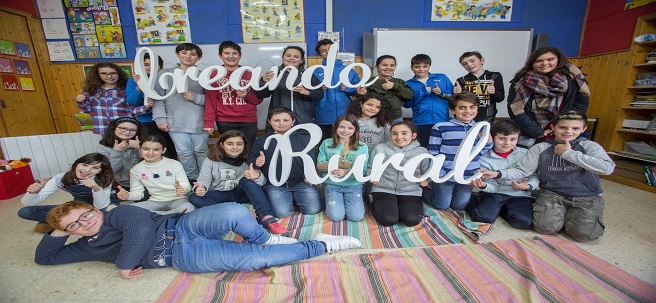
20 de January de 2020
For children, experiencing the rural environment in which they live is a discovery and a joy. It's the best way for them to grow in love with their land and want to preserve it. "EU Rural" was based on the "Participatory Local Development Strategy" they implemented in 2016, also with Leader funding. In this study, they analyzed and delved into the social reality of the inhabitants of southwest Galicia.
In 2018, the Local Action Group Asociación de Desenvolvemento Galicia Suroeste Eurural launched a competition for students from nursery and primary schools in the area where they operate, the southeast of Pontevedra. The competition, called "Creating Rural " was designed as a complement to formal educational programs, which are more general and do not focus on specific territories. Its primary objective is to educate the population about the importance of preserving rural identity and engaging children with their environment.
To achieve this, they organized this competition for schoolchildren between the ages of 3 and 12 and managed to involve 13 town councils and 28 classrooms from 13 schools in seven municipalities. The result was so successful that a second edition was held this year, and they're planning a third in 2020. " We decided to launch these educational units to instill in our children a sense of belonging to their own environments so they can establish connections through knowledge and affection ," explains Eva Gil, project leader. She continues: "This way, the little ones will become aware of the value of the land and the advantages of living in and preserving the nature they inhabit."
According to Eva Gil, a technician from the “Asociación de Desenvolvemento Galicia Suroeste Eu Rural” (Galicia Southwest Rural Development Association), “the most exciting thing is reaching the schools and making the children feel proud of living in the countryside,” she tells us in a direct translation from Galician: “ I live in the countryside.”
In addition to the success of schoolchildren's participation in "Creating Rural," we must add the quality of the projects submitted and the enormous response to the popular vote that awarded the prizes. In total, approximately 8,000 people, residents of the municipalities of Baiona, Fornelos de Montes, Gondomar, A Guarda, Mos, Nigrán, Oia, Pazos de Borbén, O Porriño, Redondela, O Rosal, Tomiño, and Tui, voted in the two editions of the competition. The expenditure over two years has amounted to approximately €32,400, financed by the Leader program for "Promoting and stimulating local development."
Furthermore, the prizes were an undeniable attraction for the students and their families. The winners in the preschool category were given a day trip to a farm school that receives LEADER grants. For the primary school winners, the trip was to the nature activity center, "Fervenzaventura," also a beneficiary of LEADER grants in Galicia. As Gil explains: "There are children in our area who haven't seen a cow because we're not in a livestock area. Being able to take them on a trip and experience their joy is incredibly satisfying, and at the same time, they learn and benefit from LEADER funds ."
COMMITTED TO THE TERRITORY
At the start of this project, EU Rural conducted an awareness and information campaign in schools and through the media to spread the word about the contest. They set up a website, www.creandorural.org , which served as a means of dissemination and information throughout the contest and, in turn, to channel the popular vote. They created an informational poster and disseminated the project on social media. They personally visited all schools, both public and private.
In parallel, they wrote and designed teaching units, adapted to the students' age groups, so that teachers could work with them in the classroom.
The ultimate goal was for students to understand their cultural, landscape, and biodiversity heritage, to recover their traditions, to understand what sustainable development is, and to participate in the future of their environment. For Eva Gil, the most important thing is that "children are able to differentiate between rural and urban areas and feel committed to their territory in order to stimulate population settlement, rejuvenate towns, and combat depopulation."
Obviously, the materials they had to submit to the competition varied depending on the children's ages. In preschool, they had to create a mural based on one of the teaching units , and in primary school, the project consisted of a video.
In each of the two editions, two winners were selected by popular vote (preschool and primary school) and two others were chosen by a jury formed to compensate for the different population densities in this area. In total, including all winners, including those jointly selected, the prizes were awarded to students in eleven classrooms across ten different schools, which means the message reached a significant portion of the population and, more importantly, had a greater impact on the youngest students.
“When we arrived at the schools, the children welcomed us as if we were celebrities, because we were the rural creatives,” says this geographer by profession who has decided to dedicate her professional activity to rural areas. “The most rewarding thing is seeing the children's faces and feeling their joy when they participate,” she continues. The enthusiasm of the schools, especially the public ones, has been rewarded with prizes that allow them to go on field trips to places they normally can't reach.
AGAINST DEPOPULATION
"EU Rural" was based on the "Participatory Local Development Strategy" they conducted in 2016, also with Leader funding. In this study, they analyzed and delved into the social reality of the inhabitants of southwest Galicia. One of the problems they encountered was that this rural area is very close to the city of Vigo, and for this reason, the population is abandoning the area to settle in the city . At the same time, they observed that the agricultural sector , primarily linked to the production of wine, fruit, and ornamental plants, is being abandoned . According to their conclusions, one of the reasons for this discouragement toward farm work is the discredit that has taken hold among the younger rural population . As agricultural activity declines, land is abandoned, biodiversity is lost, and the risk of forest fires increases.
For this reason, "Creating Rural " makes a fundamental contribution to the fight against rural abandonment and depopulation. For Eva Gil: "Rural children are our future, and we need them to understand the environment in which they live so they can protect, preserve, and develop it." It's a long-term commitment because it involves the younger generations who will take charge of the territory in the years to come.
For the National Rural Network , this initiative is an example of good practice because it is successfully raising awareness among children about the value of being part of rural society and the benefits of living surrounded by nature. As one of the second-grade children at the Serra de Vincios Primary School in Gondomar says, "We want to take advantage of the balance between humans and plants." Educating in values, generating rural pride, and offering viable and fair alternatives is the best way to keep rural areas alive.











